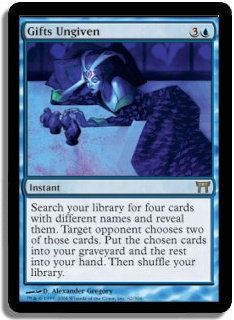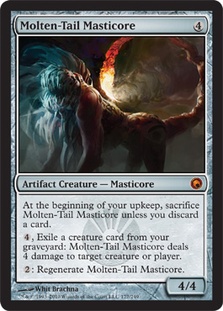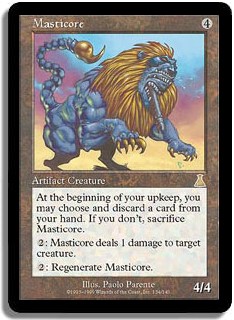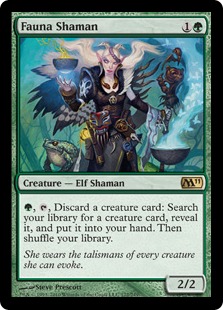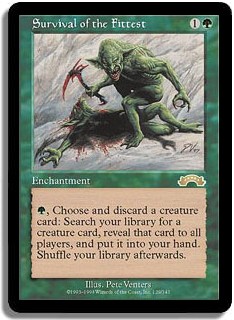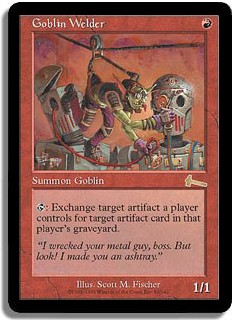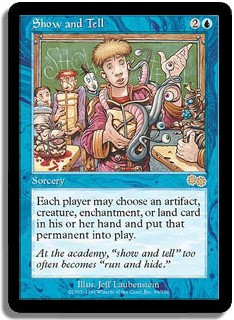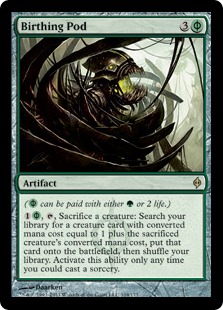In a cube draft, I was in G/U/B midrange; I took a Tezzeret, Agent of Bolas early and took a supporting cast of artifacts early to support it—cards like Mimic Vat, Wurmcoil Engine, and a Simic Signet were amongst my early picks, along with some other finishers like Frost Titan. I noticed a bunch of reanimation spells going criminally late. Cards like Animate Dead and Necromancy were going incredibly late, and they work incredibly well with cards like the Wurmcoil Engine, Frost Titan, and the Myr Battlesphere that I picked up later.
If only I could get an enabler, a Frantic Search or some other way to get them into the graveyard! I thought this until the very end of the draft and eventually cut the reanimation cards when it came down to crunch time, but if I had an enabler for them like a Frantic Search or a Survival of the Fittest, I’d have included those cards. Due to having to jettison those cards, my deck ended up weaker, and I learned a valuable lesson: looking at the enablers for reanimation in my cube.
In a previous article, I talked about cards that aren’t good on their own but can be good if they’re given proper support; how cards like Abyssal Persecutor and even Stoneforge Mystic can be unfairly dismissed as bad because supporting those cards requires some work. Some cards require thinking outside of the box (using creatures like Masticores and spellshapers like Waterfront Bouncer to help support Life from the Loam) and some merely require shaping the deck to accommodate the cards (at least one equipment for Stoneforge Mystic and several ways to kill your own Abyssal Persecutor.)Â
However, in that article and even in these examples, I didn’t really talk about cards that enable others. It’s not just the players who make the goals in sports, it’s also the players that provide the assists and set up the goals.
I’m generally a proponent of flexible enablers in Cube, and this series of articles about enablers in Cube will highlight some of these Cube multitaskers. Enabling cards are at their best when they have multiple uses to be worthwhile or are ones that are very good at their tasks if they’re narrow in scope. Entomb is a good example of this: while a card like Entomb can fetch things like a Squee, Goblin Nabob or a Bloodghast, for the most part it’s going to help enable reanimation strategies (but it’s so good at that task that cubes use it effectively even with its relatively narrow scope.)Â
In smaller cubes, the role of “flexible” enablers is especially important due to the limited space and thus, enablers should enable multiple archetypes. It’s something that I’ve been working with a lot in my blue section as I’m working on enabling multiple strategies. Cards giving support to some strategies requires having cards that need to wear many hats.
In this article, I’ll talk about some “enabler” cards for reanimation, how they can support different strategies in Cube, and how to use them effectively when drafting. I’ll be suggesting cards that can be used in different strategies and that don’t require supporting certain strategies to be good.
Building a reanimation deck in Cube is a complex puzzle of having the right reanimation targets, enough spells to make it work, and enough ways to dump those creatures into the graveyard. I won’t go too far in depth about the creatures that can be reanimated and the reanimation spells as they’re easy to identify.
Cards like Elesh Norn, Grand Cenobite and Woodfall Primus are creatures that provide an immediate impact that force the opponent to answer the creatures and effects like Animate Dead and Necromancy pull creatures from the graveyard into play at a cheap cost. Instead, I’ll focus on some other cards that help support the strategy while flexibly helping other strategies.
These are examples of cards that aren’t going to directly win you the game, but they’ll do a good job of supporting other cards in Cube decks.
Thirst for Knowledge is an example of a card that enables many types of strategies in Cube. In a previous article when I asked some StarCityGames.com writers about some draw spells in Cube, Thirst for Knowledge performed very well vote-wise, tying with Preordain. However, it’s an important enabler that’s good in most blue decks but is absolutely stellar in helping to encourage artifact based decks (like the one that I used with Tezzeret, Agent of Bolas), especially artifact based accelerators like Mind Stone and other such mana rocks.
However, Thirst for Knowledge is also a very strong card for helping to encourage reanimation decks. It can be a bit awkward to dump cards into your graveyard on turn 3 since you want to be able to cheat things into play as soon as possible (and Thirst only enables a turn 4 reanimation, assuming you don’t have another B for Reanimate), but it makes it so that you can still easily fill the graveyard for shenanigans.
Oona’s Prowler and Compulsive Research are other examples of solid enablers that can perform across various archetypes. Compulsive Research plays essentially as another Thirst for Knowledge, but Oona’s Prowler is an example of something that works in two pretty divergent archetypes: black aggro and reanimation.
While decks that typically feature Thirst for Knowledge and Compulsive Research are usually blue-based control decks that can synergize with the reanimation gameplan (like a B/U control deck that can naturally cast things like Myr Battlesphere and Massacre Wurm), that doesn’t necessarily apply to something like Oona’s Prowler. Regardless, it still enables the archetype. Although having a 1B creature whose non-discarding job can be awkward in a control deck, attacking for three isn’t the most embarrassing thing in those decks either. Just be sure to side it out vs. opposing reanimation decks!
In a recent article on what cards to cut from your Cube Justin Parnell talked about Gifts Ungiven, and while I don’t suggest cutting it from a cube (after all, why would I be talking about it here?), I’m torn between realizing that the card is indeed worse than people think and that it’s a flexible card for reanimation strategies and general blue decks. I found that when I ran it in my cube, its role was usually to get four generally useful cards, but it was best when it was acting as a 2x Entomb a la Modern U/W Gifts Tron (that got Unburial Riters and Elesh Norn.)
These examples are lumped together because they’re all just generally powerful cards that work well with reanimation. The cost argument for Thirst (that it may be too much to make the cheating into play factor worthwhile) is more so for the Masticore crew which all cost at least four (and Molten-Tail Masticore’s non-regeneration ability is a bit of a nonbo with reanimation spells), but they’re all examples of cards that you can take in a early in a draft and be confident in being able to grab a reanimation spell later in the draft if you see it since you have the ability to discard big creatures easier.
In the case of Fauna Shaman/Survival, you can easily chain the cards together. But most of these cards (at least Fauna Shaman, Survival of the Fittest, and Molten-Tail Masticore) are present in almost every cube already, so including these cards is something that is done in many cubes anyway.
It’s also worth noting that all of these cards also combine really well with cards like Squee, Goblin Nabob, another example of a card that you don’t necessarily build around (no one goes, “I’m going to build the Squee deck!”). But it’s a card that works well with a lot of other cards in cube.
Goblin Welder is an example of a card that can be built around in Cube with many different synergies, but it also works very well in reanimation decks with giant artifact creatures. Many of the best ones like Wurmcoil Engine, Myr Battlesphere, and Precursor Golem work exceptionally well with Welder as they leave tokens behind that can be welded out to bring the original creature back into play.
There are also many other extremely useful ways to use Goblin Welder like protecting your own artifacts/welding out annoying opposing artifacts (after you knock out one of them with a Manic Vandal / Keldon Vandals early in the game) and resetting artifacts like Smokestack and Tangle Wire, much like it did in Welder Stax decks in Vintage. While not many people tend to think of Goblin Welder as a card that helps enable reanimation strategies, it’s a card that definitely does when you think about it!
One of the nice things about the Magic Online Cube is that it showed people the role of cards that they previously hadn’t tried before; both Show and Tell and Sneak Attack are examples of cards that went under the radar for many people, even for those who supported reanimation decks. Both of these cards are interesting because unlike many of the previous cards mentioned like Thirst for Knowledge or Oona’s Prowler, both of these are examples of build-around-me cards but are also examples of cards that can enable reanimation strategies by complementing the strategy.
Both Sneak Attack, Show and Tell and reanimation spells like Animate Dead all work by putting a giant creature into play at a reduced cost, and some of the best ones are ones that don’t care about Sneak Attack’s sacrifice due to having strong triggers when they enter the battlefield (like the Titan cycle, Wurmcoil Engine, and Myr Battlesphere), so those cards work very well together. Since they operate at different zones than reanimation (hand versus graveyard) but work towards the same overall goal (and Sneak Attack helps to feed the graveyard) very well, both of these cards end up working well together. Even though Show and Tell doesn’t seem like it enables reanimator due to being able to be drafted around, it is an enabler!
Birthing Pod is similar in the vein of being a card that can be built around (although it doesn’t necessarily need it, you just need to make sure that your Pod chain doesn’t have any holes in it, unlike that G/U/B deck that I drafted that was missing a five-drop. Oops!), but it also enables reanimation decks by searching for creatures while dumping other ones into the graveyard. It obviously can’t cheat creatures into play on the cheap, but it does let you get more value from your reanimation spells (sacrifice my Titan, get Elesh Norn, then animate my Titan.) Much like with Sneak Attack and Show and Tell, Birthing Pod is a highly synergistic card that can enable reanimation decks but is perfectly fine on its own even if the deck has absolutely no interactions with the graveyard!
These are just a few examples of cards that can help provide some support to reanimation archetypes in your cube while also being fine cards for other strategies. If you’ve found that you are having problems with cards having support in your cube and don’t want to use cards that explicitly support those strategies, these are some examples of flexible cards you can add that can be easily used in many different strategies. Hope they help make your cube more successful and fun!
@UsmanTheRad  on Twitter
My blog featuring my cube lists:Â http://idratherbecubing.wordpress.com — including AVR changes to my cube!
Cube podcast that I and Anthony Avitollo co-host: The Third Power




